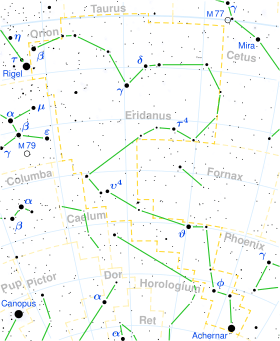Gliese 180

| |
| Observation data Epoch J2000 Equinox J2000 | |
|---|---|
| Constellation | Eridanus |
| Right ascension | 04h 53m 49.9798s[1] |
| Declination | −17° 46′ 24.294″[1] |
| Apparent magnitude (V) | 10.894[2] |
| Characteristics | |
| Evolutionary stage | Red dwarf |
| Spectral type | M2[2] |
| U−B color index | 1.155[2] |
| B−V color index | 1.549[2] |
| V−R color index | 1.018[2] |
| R−I color index | 1.205[2] |
| J−H color index | 0.553[2] |
| J−K color index | 0.815[2] |
| Astrometry | |
| Radial velocity (Rv) | 14.55 ± 0.24[3] km/s |
| Proper motion (μ) | RA: 405.2 ± 3.1[4] mas/yr Dec.: -650.6 ± 3.2[4] mas/yr |
| Parallax (π) | 80.89 ± 1.97[5] mas |
| Distance | 40.3 ± 1.0 ly (12.4 ± 0.3 pc) |
| Absolute magnitude (MV) | 10.48[2] |
| Details[6] | |
| Mass | 0.39 M☉ |
| Radius | 0.42 R☉ |
| Temperature | 3562 K |
| Other designations | |
| Database references | |
| SIMBAD | data |
| Exoplanet Archive | [http://exoplanetarchive.ipac.caltech.edu/cgi-bin/DisplayOverview/nph-DisplayOverview?objname=GJ 180 data] |
| ARICNS | data |
Gliese 180 (often shortened to GJ 180), is a red dwarf star, known to have two planets Gliese 180 b and Gliese 180 c.[3] It is located approximately 40 light-years away from Earth.[5]
According to the Planetary Habitability Laboratory (PHL) in Puerto Rico, both worlds in the system may be classifiable as potentially habitable planets. Planet Gliese 180 b and Gliese 180 c have masses of 6.4 and 8.3 Earth masses, respectively.[7] However, Dr Mikko Tuomi, of the UK’s University of Hertfordshire, whose team identified the planets, disagreed, stating:
- "The PHL adds some sort of an “extended HZ”, which I, frankly, do not know how it’s calculated, but that adds some areas of potential habitability to the inner and outer edges of the HZ as we have defined it. They included the inner companion of the GJ 180 system (planet b) that we consider too hot to be potentially habitable.”[7]
| Companion (in order from star) |
Mass | Semimajor axis (AU) |
Orbital period (days) |
Eccentricity | Inclination | Radius |
|---|---|---|---|---|---|---|
| b | 0.02611 ± 0.00558 MJ | 0.103 ± 0.0008 | 17.38 ± 0.016 | 0.11 ± 0.03 | — | — |
| с | 0.02014 ± 0.00126 MJ | 0.129 ± 0.01 | 24.329 ± 0.014 | 0.09 ± 0.07 | — | — |
External Resources
- Mikko Tuomi, Hugh R. A. Jones, John R. Barnes, Guillem Anglada-Escudé, James S. Jenkins, Bayesian search for low-mass planets around nearby M dwarfs. Estimates for occurrence rate based on global detectability statistics, arxiv.org, 3 March 2014.
References
- 1 2 van Leeuwen, F. (November 2007), "Validation of the new Hipparcos reduction", Astronomy and Astrophysics, 474 (2): 653–664, arXiv:0708.1752
 , Bibcode:2007A&A...474..653V, doi:10.1051/0004-6361:20078357
, Bibcode:2007A&A...474..653V, doi:10.1051/0004-6361:20078357 - 1 2 3 4 5 6 7 8 9 Koen, C.; Kilkenny, D.; van Wyk, F.; Marang, F. (April 21, 2010), "UBV(RI)CJHK observations of Hipparcos-selected nearby stars", Monthly Notices of the Royal Astronomical Society, 403 (4): 1949–1968, Bibcode:2010MNRAS.403.1949K, doi:10.1111/j.1365-2966.2009.16182.x
- 1 2 Wenger; et al. (March 2016), "GJ 180", The SIMBAD astronomical database, Strasbourg, France: Centre de Données astronomiques de Strasbourg, arXiv:astro-ph/0002110
 , Bibcode:2000A&AS..143....9W, doi:10.1051/aas:2000332
, Bibcode:2000A&AS..143....9W, doi:10.1051/aas:2000332 - 1 2 Høg, E.; Fabricius, C.; Makarov, V. V.; Urban, S.; Corbin, T.; Wycoff, G.; Bastian, U.; Schwekendiek, P.; Wicenec, A. (March 2000), "The Tycho-2 catalogue of the 2.5 million brightest stars", Astronomy and Astrophysics, 355 (2): L27–L30, Bibcode:2000A&A...355L..27H
- 1 2 European Space Agency (1997), The Hipparcos and Tycho catalogues; astronomic and photometric star catalogues derived from the ESA Hipparcos Space Astronomy Mission, ESA SP, 1200, Noordwijk, Netherlands: ESA Publications Division, Bibcode:1997HIP...C......0E, ISBN 9290923997, OCLC 222398081
- ↑ Turnbull, Margaret C. (October 2015), ExoCat-1: The Nearby Stellar Systems Catalog for Exoplanet Imaging Missions, arXiv:1510.01731
 , Bibcode:2015arXiv151001731T
, Bibcode:2015arXiv151001731T - 1 2 Sutherland, Paul (March 5, 2014). "Habitable planets common around red dwarf stars". Sen. Sen Corporation Ltd.
- ↑ "Planet Gj 180 b". Extrasolar Planets Encyclopaedia. Retrieved 2014-05-25.
- ↑ "Planet Gj 180 c". Extrasolar Planets Encyclopaedia. Retrieved 2014-05-25.
This article is issued from Wikipedia - version of the 11/20/2016. The text is available under the Creative Commons Attribution/Share Alike but additional terms may apply for the media files.